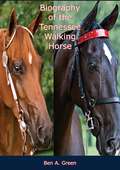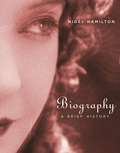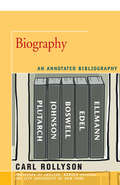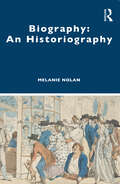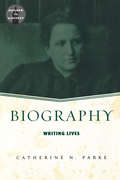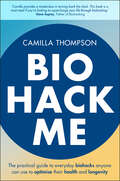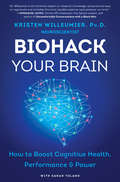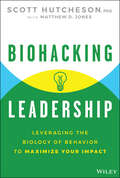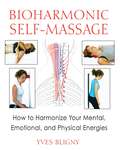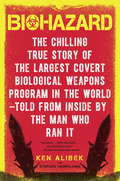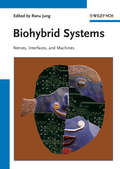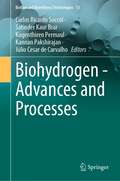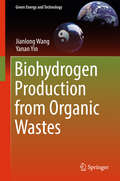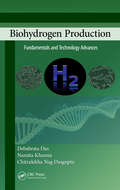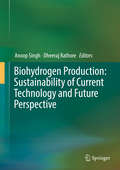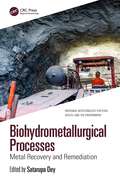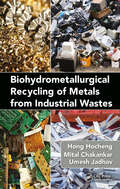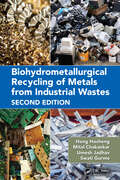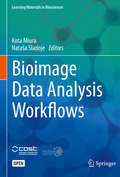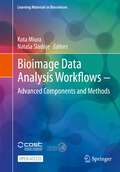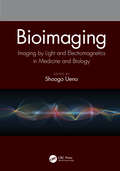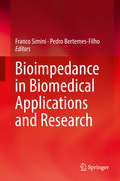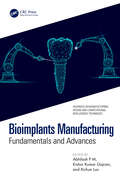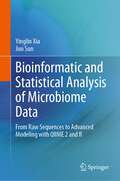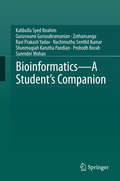- Table View
- List View
Biography of the Tennessee Walking Horse
by Ben A. GreenA NEWSPAPERMAN’S VERSION OF THE “BIG STORY” OF THE TENNESSEE WALKING HORSEThe Tennessee Walking Horse is a breed of gaited horse known for its unique four-beat running-walk and flashy movement. It was originally developed in the southern United States for use on farms and plantations. It is a popular riding horse due to its calm disposition, smooth gaits and sure-footedness. The Tennessee Walking Horse is often seen in the show ring, but is also popular as a pleasure and trail riding horse using both English and Western equipment. Tennessee Walkers are also seen in movies, television shows and other performances.
Biography: A Brief History
by Nigel HamiltonFor thousands of years we have recorded real lives--the lives of others, and of ourselves. For what purpose and for whom has this universal and timeless pursuit endured? What obstacles have lain in the path of biographers in the past, and what continues to confound biographers today? Above all, how is it that biographies and autobiographies play such a contested, popular role in contemporary Western culture, from biopics to blogs, from memoir to docudrama? Award-winning biographer and teacher Nigel Hamilton addresses these questions in an incisive and vivid narrative that will appeal to students of human nature and self-representation across the arts and sciences. Tracing the remarkable and often ignored historical evolution of biography from the ancient world to the present, this brief and fascinating tour of the genre conveys the passionate quest to capture the lives of individuals and the many difficulties it has entailed through the centuries. From the Epic of Gilgamesh to American Splendor, from cuneiform to the Internet, from commemoration to deconstruction, from fiction to fact--by way of famous biographical artists such as Plutarch, Saint Augustine, Sir Walter Raleigh, Samuel Johnson, Jean-Jacques Rousseau, Lord Byron, Sigmund Freud, Lytton Strachey, Abel Gance, Virginia Woolf, Leni Riefenstahl, Orson Welles, Julian Barnes, Ted Hughes, Frank McCourt, and many others--Nigel Hamilton's Biography: A Brief History will change the way you think about biography and real lives.
Biography: An Annotated Bibliography
by Carl RollysonThis is the only comprehensive, annotated bibliography of writing about biography. Rollyson, a biographer and scholar of biography, includes chapters on the history of biography (beginning in the Greco-Roman period and concluding with biographers such as Leon Edel and Richard Ellmann). Ample sections on psychobiography, the new feminist biography, and on biographers who appear in works of fiction, are also included. Cited in many recent books on the genre of biography, Biography: An Annotated Bibliography, is an essential research tool as well as a clearly written work for those wishing to browse through the commentary on this important genre.
Biography: An Historiography
by Melanie NolanBiography: An Historiography examines how Western historians have used biography from the nineteenth century to the present – considering the problems and challenges that historians have faced in their biographical practice systematically. This volume analyses the strategies and methods that historians have used in response to seven major issues identified over time to do with evidence, including but not limited to the problem of causation, the problem of fact and fiction, the problem of other minds, the problem of significance or representativeness, the problems of perspective, both macro and micro, and the problem of subjectivity and relative truth. This volume will be essential for both postgraduates and historians studying biography.
Biography: Writing Lives (Genres In Context Ser.)
by Catherine N. ParkeCatherine Parke explores biography through detailed examinations of Samuel Johnson, Virginia Woolf, Langston Hughes, Gertrude Stein and other masters of the genre.
Biohack Me: The Practical Guide to Everyday Biohacks Anyone Can Use to Optimise Their Health and Longevity
by Camilla ThompsonSupercharge your life. One biohack at a time. Do you struggle to prioritise your health amongst the demands of a busy lifestyle? Are you afraid of growing old and not thriving in your later years? Then maybe biohacking is for you. Biohacking is all about hacking your biology and environment so you can live better for longer. It involves making small, incremental changes to your lifestyle and diet today that will improve your health, vitality and wellbeing into the future. Biohacking proves that we have more control over ageing than what we might think. With Biohack Me, you'll discover that ageing is something we should embrace, not fear. Author Camilla Thompson is a trailblazer in biohacking, nutrition, and health coaching. As a trusted coach and wellness mentor, Camilla has dedicated nearly a decade of her life to helping others optimise their health and longevity. In this powerful guide, she provides clear, actionable strategies that will empower you to take charge of your health and protect your cognitive and physical wellbeing as you age. By learning the biohacking framework outlined in this book, you can improve your sleep, mood, health, relationships, brain and so much more. You'll learn: The importance of sleep rituals and habits, like nasal breathing and your circadian rhythm Strategies to boost your energy though intermittent fasting, red-light therapy and cold exposure How to revolutionise your relationship with stress and anxiety using the circle of control Methods to improve your nervous system function, such as breathwork and acupuncture Why neuroplasticity is crucial for optimum long-term brain function How a nutrient-rich diet, hydration hacks and cognitive training can improve your overall brain health Once you master the biohacking basics, you will unlock your full potential and transform your mind and body for the better. Whether you're a health newbie or a seasoned wellness warrior, Biohack Me is your ticket to supercharging your life.
Biohack Your Brain: How to Boost Cognitive Health, Performance & Power
by Kristen WilleumierA neuroscientist’s groundbreaking, science-driven plan for revitalizing, nourishing and rejuvenating your most essential asset—your brain.Your brain is the most essential organ in your body. The brain and spinal cord are intimately connected to every bodily system and organ, so when it is balanced everything in your body and mind will function more efficiently. It’s vitally important to take proactive steps now, or you risk losing everything, including your ability to think clearly, be creative, remember details, solve problems and retain your memory.In Biohack Your Brain, leading neuroscientist Dr. Kristen Willeumier reveals how you can change your brain by making simple and easy modifications to your lifestyle. Combining clinical experience with revolutionary science, she details how biohacking your brain can boost your cognitive performance and so much more.Dr. Willeumier’s essential guidebook shows you the most effective techniques to prevent memory loss and neurodegenerative disorders like Alzheimer’s disease—and even how to overcome negative thoughts and stress. Through research and case studies, you’ll learn how to upgrade your nutritional choices along with the effective use of supplements, brain games, and physical activity to overcome cognitive damage, whether it’s from previous injuries, such as a concussion or a bad fall or from the effects of living in modern day times.Dr. Willeumier shares her own story alongside those from the NFL players and other clients she has worked with to help you leverage the latest research to find personal solutions. Biohack Your Brain teaches you how to take better care of your brain, and also how to enhance your memory, lose excess weight, increase your energy and vitality in order to create the best health and life possible.
Biohacking Leadership: Leveraging the Biology of Behavior to Maximize Your Impact
by Scott HutchesonRethinking leadership through a scientific approach to human connection and performance Built on a dual foundation of rigorous research and real-world application, Biohacking Leadership: Leveraging the Biology of Behavior to Maximize Your Impact explores how leaders can apply biohacking principles to understanding and leverage the biological and behavioral drivers of decision-making, influence, and impact. The first in a three-part series, this book discusses how to optimize your leadership by using neuroscience and biomechanics to enhance your mental and physical state, fostering more effective communication, emotional regulation, and collaboration. Each concept and strategy in this book is informed by science, but the insights are presented in an accessible, actionable way, discussing topics including: The concept of leadership biodynamics as a set of three channels and the 18 biometric signals that represent the essential dimensions of effective leadership: warmth, competence, and gravitas How insights from nature's keystone species—beavers, wolves, and sea stars—illustrate the impact of creating balance, inclusivity, and shared value How to deliver results with clarity and credibility by mastering complexity, decision-making, and alignment with strategic goals The critical role of creativity, adaptability, and play in fostering innovation, resilience, and team cohesion Biohacking Leadership: Leveraging the Biology of Behavior to Maximize Your Impact is an essential guide for all professionals seeking to harness cutting-edge scientific research and developments and to bring their organizations to new heights.
Bioharmonic Self-Massage: How to Harmonize Your Mental, Emotional, and Physical Energies
by Yves BlignySelf-massage techniques to heal the body, mind, and spirit • Includes self-massage techniques to clear the body’s blocked energy circuits, relieve physical tensions and chronic pain, release trapped emotions, and reduce stress and anxiety • Contains full-color illustrations throughout demonstrating bioharmonic massage, movement, and stretching exercises • Demonstrates how to use common objects to work on hard-to-reach problem areas, including the neck, shoulders, and back, to relieve pain and increase fluidity of movement Drawing upon biological decoding, reflexology, lymph massage, and yoga as well as recent neuroscience and quantum physics research, therapist and kinesiologist Yves Bligny shows how to awaken the body’s natural potential to harmonize energy through the release of tensions and emotional memories trapped within our muscles. He explains how the synergy between the physical body, emotions, thoughts, energy, and consciousness creates a delicate balance, or “bioharmony,” that can be tuned and adjusted through self-massage. Using the power of intention--directed thought aided by expanded awareness of the body--as well as tubes, wands, tennis balls, and other common objects to reach hard-to-massage problem areas, Bligny shows how to take inventory of your body, mind, and memories and use the conscious touch of self-massage to remove energy blockages, release trapped emotions, and relieve anxieties, stress, and muscle tensions as well as gain stability and strength. Effective for chronic back, neck, and shoulder problems, the movements and stretching exercises of bioharmonic self-massage can also be used to increase fluidity of motion, ward off illness, and attain a state of bioharmonic--physical, emotional, mental, and energetic--well-being.
Biohazard: The Chilling True Story of the Largest Covert Biological Weapons Program in the World--Told from the Inside by the Man Who Ran It
by Stephen Handelman Ken AlibekImagine a hot zone in which Ebola is being spliced--using the latest techniques of genetic engineering--with smallpox, the most infectious disease known to man. Now imagine that cocktail is meant for you. For fifty years, while the world stood in terror of a nuclear war, Russian scientists hidden in heavily guarded secret cities refined and stockpiled a new kind of weapon of mass destruction--an invisible weapon that would strike in silence and could not be traced. It would leave hundreds of thousands dead in its wake and would continue to spread devastation long after its release. The scientists were bioweaponeers, working to perfect the tools of a biological Armageddon. They called it their Manhattan Project. It was the deadliest and darkest secret of the cold war. What you are about to read has never before been made public. Ken Alibek began his career as a doctor wanting to save lives and ended up running the Soviet biological weapons program--a secret military empire masquerading as a pharmaceutical company. At its peak, the program employed sixty thousand people at over one hundred facilities. Seven reserve mobilization plants were on permanent standby, ready to produce hundreds of tons of plague, anthrax, smallpox, and Venezuelan equine encephalitis, to name only a few of the toxic agents bred in Soviet labs. Almost every government ministry was implicated, including the Academy of Sciences and the KGB. Biohazard is a terrifying, fast-paced account of tests and leaks, accidents and disasters in the labs, KGB threats and assassinations. The book is full of revelations--evidence of biowarfare programs in Cuba and India, actual deployments at Stalingrad and in Afghanistan, experiments with mood-altering agents, a contingency plan to attack major American cities, and the true story behind the mysterious anthrax outbreak in Sverdlovsk. But beyond these is a twisted world of lies and mirrors, and the riveting parable of the greatest perversion of science in history. No one knows the actual capabilities of biological weapons better than Dr. Alibek. Many of the scientists who worked with him have been lured away from low-paying Russian labs to rogue regimes and terrorist groups around the world. In our lifetime, we will most likely see a terrorist attack using biological weapons on an American city. Biohazard tells us--in chilling detail--what to expect and what we can do. Not since Arthur Koestler's Darkness at Noon has there been such a book--a report from inside the belly of the beast.Praise for Biohazard "Harrowing . . . richly descriptive . . . [an] absorbing account."--The New York Times Book Review "Remarkable . . . terrifying revelations . . . [Ken Alibek's] overall message is ignored at great national peril."--Newsday "Read and be amazed. . . . An important and fascinating look into a terrifying world of which we were blissfully unaware."--Robin Cook, author of ContagionFrom the Hardcover edition.
Biohybrid Systems: Nerves, Interfaces and Machines
by Ranu JungThe discipline of neurodesign is a highly interdisciplinary one, while at the same time in the process of maturing towards real-life applications. The breakthrough about to be achieved is to close the loop in communication between neural systems and electronic and mechatronic systems and actually let the nervous system adapt to the feedback from the man-made systems. To master this loop, scientists need a sound understanding of neurology, from the cellular to the systems scale, of man-made systems and how to connect the two. These scientists comprise medical scientists, neurologists and physiologists, engineers, as well as biophysicists. And they need the topics in a coherently written work with chapters building upon another.
Biohydrogen - Advances and Processes (Biofuel and Biorefinery Technologies #13)
by Satinder Kaur Brar Carlos Ricardo Soccol Kugenthiren Permaul Kannan Pakshirajan Júlio Cesar de CarvalhoThis book presents an introduction to biohydrogen production and the recent advances and developments of the cleanest biofuel produced from bioresources. Biohydrogen has the highest energy content relative to weight and burns cleanly – generating just water. It is the best choice for fuel cells, where it generates electricity directly, in its reaction with oxygen. Biohydrogen occurs naturally as part of digestive gases from mammals and can be produced in specially designed anaerobic biodigesters, or through photocatalysis with microalgae. The gas is also easy to purify and use. The economic production of biohydrogen is still full of challenges: From the efficient and rapid conversion of the substrate to storage, transportation, and safe use, there are several aspects that need to be developed. Research in this field is addressing the issue of efficient large-scale production from several directions: Substrate pretreatment to enhance digestibility, metabolic networks analysis, microbial diversity and succession to highlight constraints in production, bioreactor, and downstream design to improve throughput and reduce costs, to name a few. The ideas and technologies presented in this book contribute to achieving the UN Sustainable Development Goal 7: Affordable and Clean Energy. The book is written for researchers and students interested in biorefinery and biofuel technologies.
Biohydrogen Production from Organic Wastes (Green Energy and Technology)
by Jianlong Wang Yanan YinThis book comprehensively introduces fundamentals and applications of fermentative hydrogen production from organic wastes, consisting of eight chapters, covering the microbiology, biochemistry and enzymology of hydrogen production, the enrichment of hydrogen-producing microorganisms, the pretreatment of various organic wastes for hydrogen production, the influence of different physicochemical factors on hydrogen production, the kinetic models and simulation of biological process of fermentative hydrogen production, the optimization of biological hydrogen production process and the fermentative hydrogen production from sewage sludge. The book summarizes the most recent advances that have been made in this field and discusses bottlenecks of further development. This book gives a holistic picture of this technology and details the knowledge through illustrative diagrams, flow charts, and comprehensive tables. It is intended for undergraduate and graduate students who are interested in bioenergy and wastes management, researchers exploring microbial fermentation process, and engineers working on system optimization or other bioenergy applications.
Biohydrogen Production: Fundamentals and Technology Advances
by Debabrata Das Namita Khanna Chitralekha Nag DasguptaThis book compiles the fundamentals of biohydrogen production technology. It offers comprehensive coverage of microbiology, biochemistry, feedstock requirements, and molecular biology of the biological hydrogen production processes. It also gives insight into scale-up problems and limitations. In addition, the book discusses mathematical modeling of the processes involved in biohydrogen production and the software required to model the processes. It also summarizes research advances, discusses bottlenecks of the various processes, and covers the process economy, policy, and environmental impact of this technology.
Biohydrogen Production: Sustainability of Current Technology and Future Perspective
by Anoop Singh Dheeraj RathoreIncrease in green, renewable and sustainable energy demand due to higher environmental impacts (e. g. Greenhouse gases emissions, climate change, etc. ) on consumption of fossil fuel resource put down an extra pressure on government, researchers and industrialists. Among several available biofuel options, biohydrogen is considered as one of the best environmentally clean fuel and a strong candidate to fulfil the future demand of sustainable energy resource. Although, biohydrogen production technology and its use as a fuel is still in infancy stage. Selection of most sustainable production pathway, increase in production upto industrial scale and cost efficiency are some issue still persist with the biohydrogen research. "Biohydrogen Production: Sustainability of Current Technology and Future Perspective" is giving an insight for the sustainable production of biohydrogen at industrial scale. The process of biohydrogen production is complex and to opt the best suited production system for industrial scale is a frantic task. This book will provide an in depth information on all available technologies for biohydrogen production and feedstock options to choose upon. This book is also providing information on present status of the research in the field and possibility to change future fuel economy in to biohydrogen economy. Experts views provided in the chapters by renowned researchers from all over the globe in the field of biohydrogen research made this book a cornucopia of present research and future perspective of biohydrogen. This book is targeted at the researchers working on biohydrogen as well as the bioenergy scientist planning to move towards biohydrogen research. This book will provide a platform for motivation of researchers and industrialists for innovative ideas and thoughts to bring biohydrogen production at industrial scale.
Biohydrometallurgical Processes: Metal Recovery and Remediation (Microbial Biotechnology for Food, Health, and the Environment)
by Satarupa DeyExtensive industrialization has led to an increased release of toxic metals into the soil and air. Industrial waste can include mine overburden, bauxite residue, and E waste, and these can serve as a source of valuable recoverable metals. There are relatively simple methods to recycle these wastes, but they require additional chemicals, are expensive, and generate secondary waste that causes environmental pollution. Biohydrometallurgical processing is a cost-effective and ecofriendly alternative where biological processes help conserve dwindling ore resources and extract metals in a nonpolluting way. Microbes can be used in metal extraction from primary ores, waste minerals, and industrial and mining wastes. Biohydrometallurgical Processes: Metal Recovery and Remediation serves as a useful guide for microbiologists, biotechnologists, and various industrialists dealing with mining, metallurgy, chemical engineering, and environmental sciences. Features: Examines advances in biohydrometallurgy, biomineralization, and bioleaching techniques Discusses the importance of bacteria in biohydrometallurgical processes and microbial interventions for waste cleanup and upgradation of minerals Presents the latest techniques for biosynthesis related to different metals, along with recent developments in alternative procedures using extremophiles and leaching bacteria
Biohydrometallurgical Recycling of Metals from Industrial Wastes
by Hong Hocheng Mital Chakankar Umesh JadhavAlthough many available metal recycling methods are simple and fast, they are also expensive and cause environmental pollution. Biohydrometallurgical processing of metals offers an alternative to overcome these issues, as the use of biological means not only helps to conserve dwindling ore resources but also fulfills the need for the unambiguous need to extract metals in nonpolluting, low-energy, and low-cost way. This book covers biohydrometallurgy and its application in the recovery of metals from secondary sources like wastes. It aims to provide readers with a comprehensive overview of different wastes for metal recovery and biological treatment methods that are both environmentally friendly and economically viable.
Biohydrometallurgical Recycling of Metals from Industrial Wastes
by Hong Hocheng Mital Chakankar Umesh Jadhav Swati GurmeAlthough many available metal recycling methods are simple and fast, they are also expensive and cause environmental pollution. Biohydrometallurgical processing of metals offers an alternative to overcome these issues, as the use of biological means not only helps to conserve dwindling ore resources but also fulfills the unambiguous need to extract metals in nonpolluting, low-energy, and low-cost way. This book covers biohydrometallurgy and its application in the recovery of metals from secondary sources like wastes. Fully updated for a new edition, it provides readers with a comprehensive overview of different wastes for metal recovery and biological treatment methods that are both environmentally friendly and economically viable. Offers a detailed explanation about generation of different metals containing industrial waste Explains traditional and new biological methods of recycling Reflects research advances across different industrial waste sources including electric vehicle batteries and LCDs from computers and other devices Focuses on each waste type and explores in detail the biohydrometallurgical recovery of metals from that waste Discusses fundamental microbial studies in bioleaching and updates about the use of emerging technologies and integrated techniques with different methods in combination for metal recovery Features a new chapter on techniques for metal extraction from bioleachate This book serves as an essential resource for researchers and professional engineers working in chemical and environmental engineering and biotechnology.
Bioimage Data Analysis Workflows (Learning Materials in Biosciences)
by Kota Miura Nataša SladojeThis Open Access textbook provides students and researchers in the life sciences with essential practical information on how to quantitatively analyze data images. It refrains from focusing on theory, and instead uses practical examples and step-by step protocols to familiarize readers with the most commonly used image processing and analysis platforms such as ImageJ, MatLab and Python. Besides gaining knowhow on algorithm usage, readers will learn how to create an analysis pipeline by scripting language; these skills are important in order to document reproducible image analysis workflows. The textbook is chiefly intended for advanced undergraduates in the life sciences and biomedicine without a theoretical background in data analysis, as well as for postdocs, staff scientists and faculty members who need to perform regular quantitative analyses of microscopy images.
Bioimage Data Analysis Workflows ‒ Advanced Components and Methods (Learning Materials in Biosciences)
by Kota Miura Nataša SladojeThis open access textbook aims at providing detailed explanations on how to design and construct image analysis workflows to successfully conduct bioimage analysis. Addressing the main challenges in image data analysis, where acquisition by powerful imaging devices results in very large amounts of collected image data, the book discusses techniques relying on batch and GPU programming, as well as on powerful deep learning-based algorithms. In addition, downstream data processing techniques are introduced, such as Python libraries for data organization, plotting, and visualizations. Finally, by studying the way individual unique ideas are implemented in the workflows, readers are carefully guided through how the parameters driving biological systems are revealed by analyzing image data. These studies include segmentation of plant tissue epidermis, analysis of the spatial pattern of the eye development in fruit flies, and the analysis of collective cell migration dynamics. The presented content extends the Bioimage Data Analysis Workflows textbook (Miura, Sladoje, 2020), published in this same series, with new contributions and advanced material, while preserving the well-appreciated pedagogical approach adopted and promoted during the training schools for bioimage analysis organized within NEUBIAS – the Network of European Bioimage Analysts. This textbook is intended for advanced students in various fields of the life sciences and biomedicine, as well as staff scientists and faculty members who conduct regular quantitative analyses of microscopy images.
Bioimaging: Imaging by Light and Electromagnetics in Medicine and Biology
by Shoogo UenoBioimaging: Imaging by Light and Electromagnetics in Medicine and Biology explores new horizons in biomedical imaging and sensing technologies, from the molecular level to the human brain. It explores the most up-to-date information on new medical imaging techniques, such as the detection and imaging of cancer and brain diseases. This book also provides new tools for brain research and cognitive neurosciences based on new imaging techniques. Edited by Professor Shoogo Ueno, who has been leading the field of biomedical imaging for 40 years, it is an ideal reference book for graduate and undergraduate students and researchers in medicine and medical physics who are looking for an authoritative treatise on this expanding discipline of imaging and sensing in medicine and biology. Features: Provides step-by-step explanations of biochemical and physical principles in biomedical imaging Covers state-of-the art equipment and cutting-edge methodologies used in biomedical imaging Serves a broad spectrum of readers due to the interdisciplinary topic and approach Shoogo Ueno, Ph.D, is a professor emeritus of the University of Tokyo, Tokyo, Japan. His research interests include biomedical imaging and bioelectromagnetics, particularly in brain mapping and neuroimaging, transcranial magnetic stimulation (TMS), and magnetic resonance imaging (MRI). He was the President of the Bioelectromagnetics Society, BEMS (2003-2004) and the Chairman of the Commission K on Electromagnetics in Biology and Medicine of the International Union of Radio Science, URSI (2000-2003). He was named the IEEE Magnetics Society Distinguished Lecturer during 2010 and received the d’Arsonval Medal from the Bioelectromagnetics Society in 2010.
Bioimpedance in Biomedical Applications and Research
by Franco Simini Pedro Bertemes-FilhoThis book is based on the best contributions to the advancement of bioimpedance knowledge and use from the Latin American Congress series, CLABIO. Basic bioimpedance facts as well as promising and original contributions to bioimpedance theory and applications are presented, giving the reader stimulating material for reflection, decision making, and further experiments. Contributions come from a diverse international pool of experts and address topics on electrode and skin impedance modelling, tomography, spectroscopy, instrumentation, and clinical applications.
Bioimplants Manufacturing: Fundamentals and Advances (Advances in Manufacturing, Design and Computational Intelligence Techniques)
by Xichun Luo Kishor Kumar Gajrani Abhilash P MThe text covers fundamentals and technological advancements in processing, post-processing, and surface engineering of bioimplant materials. It further discusses important topics such as the additive manufacturing of bioimplants, the tribological performance of bioimplants, and the hybrid and non-traditional manufacturing of bioimplants materials. The text also presents the latest advancements in intelligent bioimplant manufacturing using artificial intelligence and machine learning.This book: Offers an in-depth understanding of the fundamentals, types, materials and applications of bioimplants Highlights the effect of processing on microstructure, biocompatibility, and mechanical behavior of bioimplants Investigates the surface modification methods and tribological performance of bioimplants Discusses additive manufacturing and non-traditional manufacturing techniques such as electrical discharge machining and electrochemical machining of bioimplants materials Covers smart technologies such as artificial intelligence and machine learning-based intelligent implant manufacturing for Industry 4.0 It is primarily written for senior undergraduate and graduate students and academic researchers in the fields of mechanical engineering, biomedical engineering, production engineering, industrial engineering, aerospace engineering, and manufacturing engineering.
Bioinformatic and Statistical Analysis of Microbiome Data: From Raw Sequences to Advanced Modeling with QIIME 2 and R
by Jun Sun Yinglin XiaThis unique book addresses the bioinformatic and statistical modelling and also the analysis of microbiome data using cutting-edge QIIME 2 and R software. It covers core analysis topics in both bioinformatics and statistics, which provides a complete workflow for microbiome data analysis: from raw sequencing reads to community analysis and statistical hypothesis testing. It includes real-world data from the authors’ research and from the public domain, and discusses the implementation of QIIME 2 and R for data analysis step-by-step. The data as well as QIIME 2 and R computer programs are publicly available, allowing readers to replicate the model development and data analysis presented in each chapter so that these new methods can be readily applied in their own research. Bioinformatic and Statistical Analysis of Microbiome Data is an ideal book for advanced graduate students and researchers in the clinical, biomedical, agricultural, and environmental fields, as well as those studying bioinformatics, statistics, and big data analysis.
Bioinformatics - A Student's Companion
by Kalibulla Syed Ibrahim Guruswami Gurusubramanian Zothansanga Ravi Prakash Yadav Nachimuthu Senthil Kumar Shunmugiah Karutha Pandian Probodh Borah Surender MohanThis manual offers a stand-alone reading companion, unique in simplifying the practical components of Bioinformatics in a unique and user-friendly manner. It covers the practical component of syllabi used at most leading universities and discusses the most extensively used tools and methodologies in Bioinformatics. Research in the biological sciences has made tremendous strides in recent years due in part to the increased automation in data generation. At the same time, storing, managing and interpreting huge volumes of data has become one of the most challenging tasks for scientists. These two aspects have ultimately necessitated the application of computers, giving rise to a highly interdisciplinary discipline-Bioinformatics. Despite the richness of bioinformatics resources and methods, the exposure of life sciences undergraduates and postgraduates to bioinformatics is extremely limited. Though the internet offers various tools for free, and provides guides for using them, it fails to help users interpret the processed data. Moreover, most sites fail to update their help pages to accommodate software upgrades. Though the market is flooded with books discussing the theoretical concepts in Bioinformatics, a manual of this kind is rarely found. The content developed to meet the needs of readers from diverse background and to incorporate the syllabi of undergraduate and postgraduate courses at various universities.
